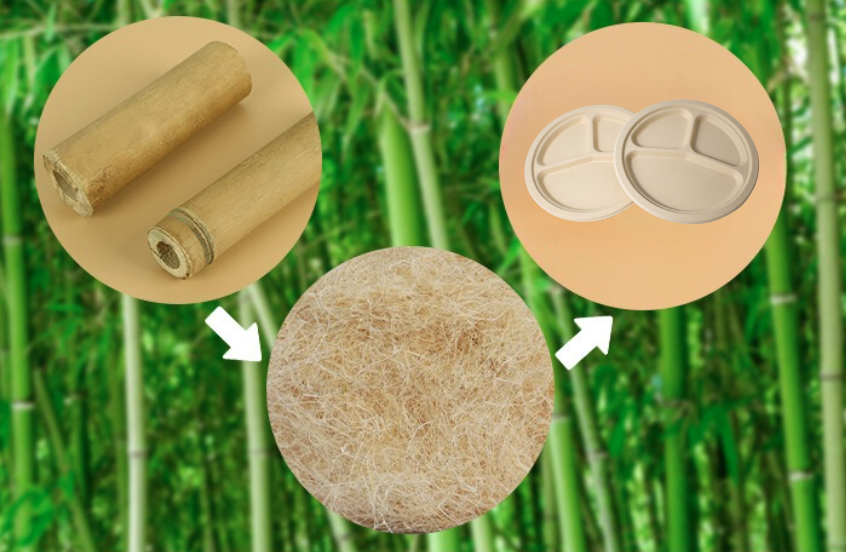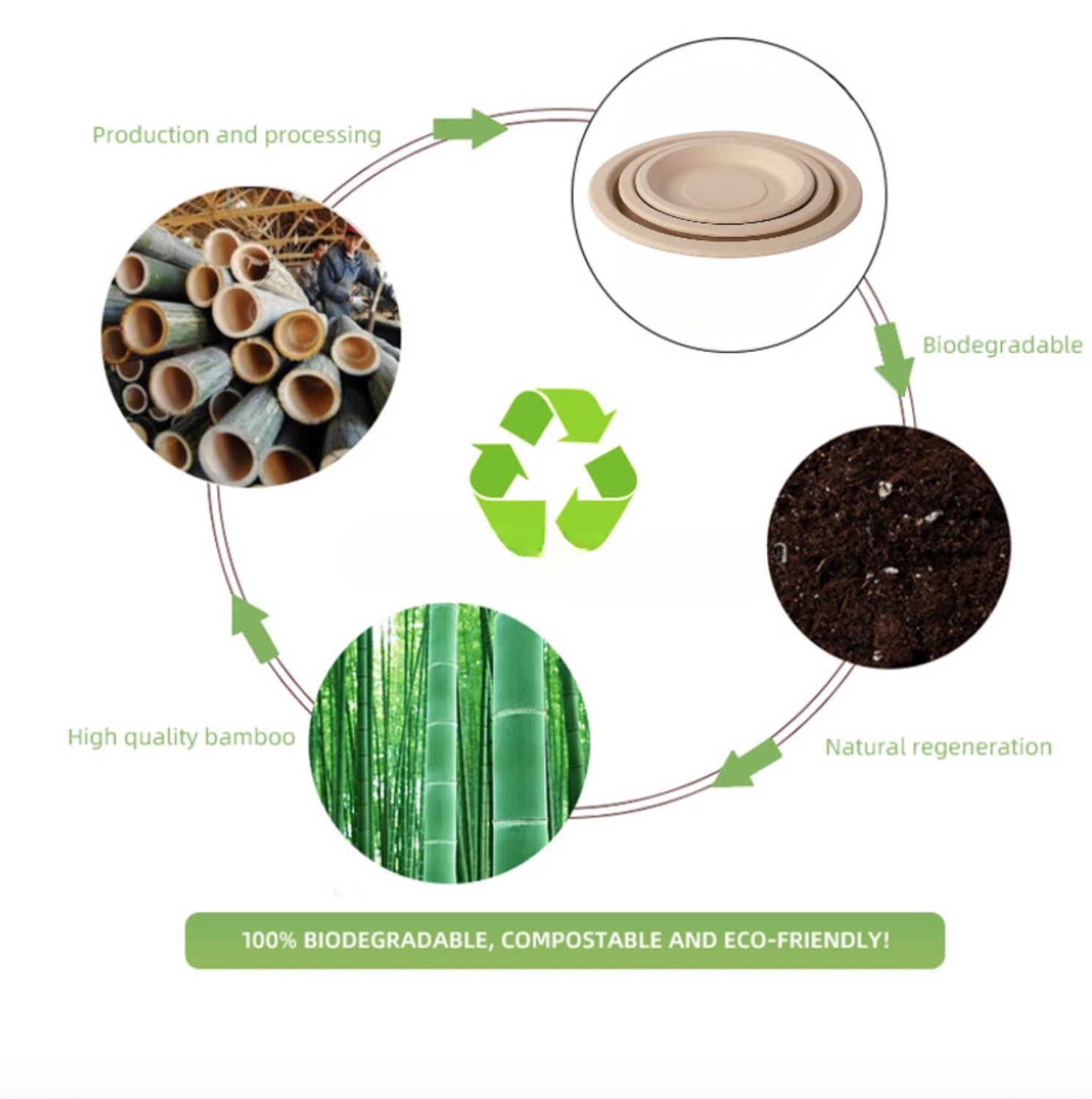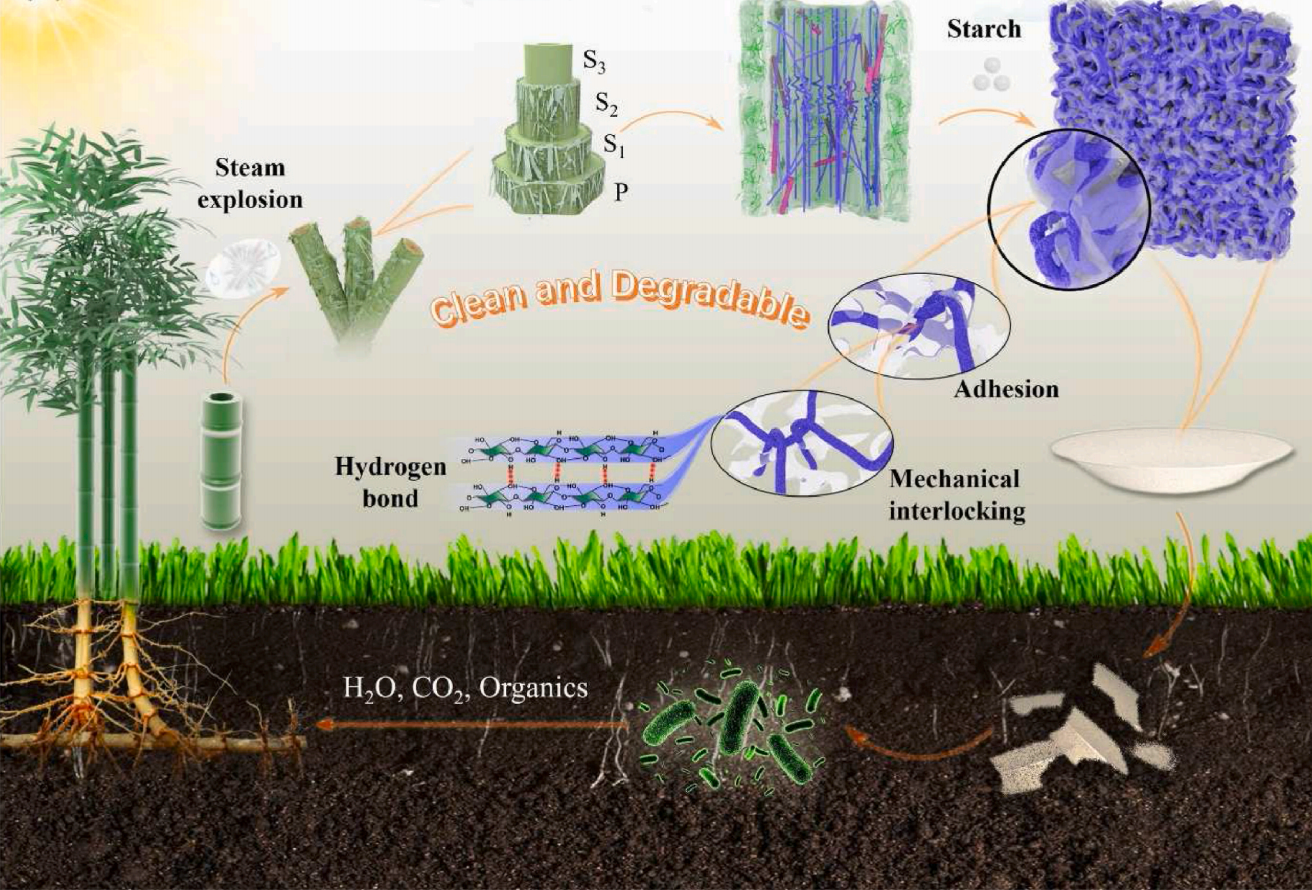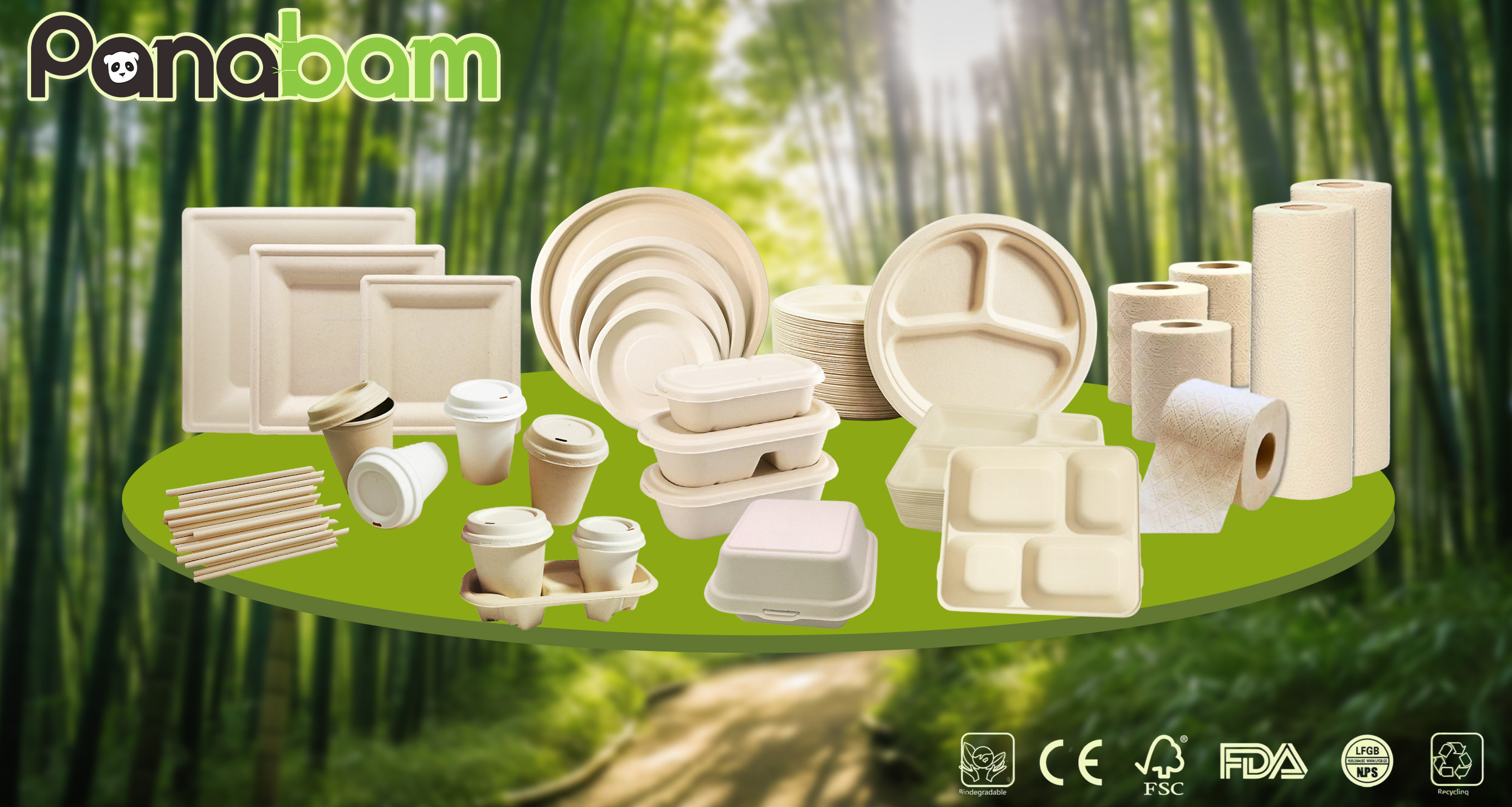Plastic pollution is threatening the environment globally, and consumers are searching for better alternatives. Bamboo disposable plates offer an eco-friendly dining solution by addressing sustainability concerns while providing practical benefits. As a result, these plates are gaining traction in the market.

Bamboo Transformation to Disposable Plates
Bamboo disposable plates are made from raw bamboo, which is transformed into fibers and shaped into plates. These plates decompose quickly, are sustainable, and help reduce pollution compared to traditional plastic plates. However, are they truly the best choice? Let’s explore further.
What Makes Bamboo Sustainable?
Sustainability has become a critical factor in addressing environmental challenges. Unlike traditional materials like plastic and timber, bamboo grows faster and regenerates efficiently. Because of this, bamboo is an excellent alternative for those seeking sustainable options.
Bamboo grows rapidly, regenerates after harvest, and uses fewer resources than other materials, making it eco-friendly.

How Does Bamboo’s Growth Support Sustainability?
Bamboo is one of the fastest-growing plants in the world. For example, it matures in just 3–5 years, unlike trees, which take decades. This rapid growth makes bamboo a renewable resource. Moreover, after harvesting, bamboo regrows without replanting, preventing deforestation. Its efficient growth cycle also reduces the need for fertilizers or pesticides, minimizing environmental damage.
Resource Efficiency of Bamboo Production
Compared to timber, bamboo requires less water and space to grow. Its higher yield per acre makes it a cost-effective solution for manufacturers. Additionally, bamboo’s natural properties reduce the need for chemical treatments. Below is a comparison:
| Material | Growth Time | Water Usage | Replanting Required |
|---|---|---|---|
| Bamboo | 3–5 years | Low | No |
| Timber | 10–30 years | High | Yes |
These qualities make bamboo an excellent raw material for sustainable products.
Carbon Sequestration Capabilities
Bamboo’s carbon sequestration capabilities play a key role in reducing greenhouse gases. It absorbs CO₂ more efficiently than most trees and releases 35% more oxygen into the atmosphere. Because of this, bamboo farming not only provides renewable materials but also contributes to combating climate change. Here’s a quick comparison:
| Plant Type | CO₂ Absorption Rate | Oxygen Output |
|---|---|---|
| Bamboo | High | 35% more than trees |
| Average Hardwood | Moderate | Standard levels |
Thus, bamboo offers significant environmental benefits that extend beyond just rapid growth.
What Is the Environmental Impact of Bamboo Tableware?
The production and disposal of tableware have a major impact on the environment. Plastic plates, for instance, take centuries to degrade. In contrast, bamboo plates decompose within months, making them a sustainable alternative. Additionally, they use natural materials that reduce pollution and ensure safety for users.
Bamboo plates are biodegradable, require less energy to produce, and are free of harmful chemicals. Therefore, they have a much smaller environmental footprint than traditional disposable options.

Why Are Bamboo Plates Better for the Environment?
Bamboo plates decompose in 3–6 months under proper conditions, unlike plastic plates, which remain for centuries. Additionally, their production uses fewer chemicals and less energy, resulting in a smaller carbon footprint. Furthermore, bamboo plates do not release toxic substances when disposed of, ensuring safety for both the environment and human health.
Low-Energy Production Process
Producing bamboo tableware requires less energy than traditional plastic or even paper products. For instance, manufacturers utilize the natural fibers of bamboo, which need minimal processing. Below is an energy comparison:
| Material | Energy Use | Carbon Emissions |
|---|---|---|
| Bamboo Tableware | Low | Low |
| Plastic Tableware | High | High |
| Paper Tableware | Medium | Medium |
As a result, bamboo tableware provides a sustainable solution with reduced environmental impact.
Challenges in Disposal and Recycling
Although bamboo plates biodegrade naturally, disposal methods can vary based on regional infrastructure. For example, in areas with composting facilities, bamboo plates decompose effectively. However, in landfills, oxygen-starved conditions may slow the process. Recycling bamboo tableware is less common, but its natural composition ensures it does not leave toxic residues. Here’s an analysis:
| Disposal Method | Plastic Plates | Bamboo Plates |
|---|---|---|
| Landfill Decomposition Time | Hundreds of years | 3–6 months |
| Composting | Not Suitable | Highly Suitable |
| Recycling | Limited (downcycling) | Not Necessary |
This analysis highlights how proper composting infrastructure is crucial to maximizing bamboo’s environmental benefits.
How Does Bamboo Compare to Other Disposable Tableware?
Bamboo stands out as one of the most sustainable and versatile materials for disposable tableware. However, to fully understand its value, it’s essential to compare bamboo with other popular materials like wood, palm leaf, sugarcane, and paper. Each has its strengths and weaknesses, but bamboo offers a unique combination of benefits that make it a top choice for eco-conscious consumers.

Key Comparison: Bamboo vs. Other Materials
When selecting a disposable tableware material, it’s crucial to consider factors like heat resistance, waterproofing, and compostability. Here’s how the most popular materials compare across various dimensions:
| Feature | Bamboo | Palm Leaf | Sugarcane | Wood | Paper |
|---|---|---|---|---|---|
| Freezable | Yes | Yes | Yes | Yes | No |
| Microwavable | Yes | No | Yes | Yes | No |
| Water & Oil Proof | Yes | Yes | No | Yes | No |
| Food Grade | Yes | Yes | Yes | Yes | Yes |
| Home Compostable | Yes | Yes | Yes | Yes | Yes |
| Eco-Friendly | Yes | Yes | Yes | Yes | Yes |
| Sustainable | Yes | Yes | Yes | Yes | No |
| Biodegradable | Yes | Yes | Yes | Yes | Yes |
Why Multi-Dimensional Comparison Matters
Choosing the right material is more than just about its environmental impact. You also need to consider how well the material performs in real-world conditions. Bamboo and palm leaf are both highly sustainable and have strong resistance to heat, which makes them excellent options for food containers. Bamboo, in particular, is known for its durability and can be microwaved, which is important for many foodservice applications.
On the other hand, materials like sugarcane and paper, while biodegradable and compostable, tend to be less heat-resistant. They are suitable for cold foods but may not be the best choice for hot or oily dishes.
Understanding these factors ensures that businesses can make informed choices when sourcing eco-friendly disposable tableware.
What Are the Market Trends for Bamboo Tableware?
The global bamboo tableware market is expanding rapidly. According to a recent Allied Market Research report, The global bamboo fiber tableware & kitchenware market was valued at USD 356 Mn in 2023 and is estimated to grow at a CAGR of over 5.8% from 2024 to 2032. Driven by a rising consumer preference for eco-friendly and biodegradable products, the market is experiencing notable growth. Bamboo fiber tableware and kitchenware have emerged as sustainable alternatives to plastic, resonating with global initiatives aimed at curbing single-use plastic consumption..
Why Is the Market Growing?
Several factors are driving this growth:
- Government Regulations and Plastic Bans: Laws like the EU Single-Use Plastics Directive and U.S. state bans are increasing demand for bamboo tableware.
- Rising Consumer Awareness: Over 67% of global consumers prefer eco-friendly products, according to Statista.
- Food Industry Adoption: Brands like Starbucks and McDonald’s are shifting to plant-based packaging and tableware.
Regional Market Insights
The bamboo tableware market varies significantly by region. Below is an analysis:
| Region | Market Drivers | Key Trends |
|---|---|---|
| North America | Government regulations, high awareness | Growing demand in chain supermarkets and online platforms |
| Europe | Strict plastic bans, high sustainability focus | Rise in reusable and biodegradable bamboo products |
| Asia-Pacific | Cost-effective production, increasing export potential | Large-scale manufacturing hubs in China and Vietnam |
These trends highlight the increasing importance of bamboo tableware in addressing global environmental challenges.
Conclusion
Bamboo disposable plates combine renewability, eco-friendly production, and superior biodegradability. With growing consumer demand and global regulations, bamboo tableware is set to become a key player in sustainable dining solutions. Choosing bamboo helps protect the environment while supporting a sustainable future.
Panabam: Your Eco-friendly Disposable Foodservice Manufacturer
Panabam leverages a strong NPD pipeline to meet evolving food and drink trends, global market opportunities, and consumer behaviors like increased home delivery. We explore plant-based materials that are food-safe and certified compostable, enabling us to innovate with new, sustainable applications in foodservice packaging.
- Website: www.panabam.com
- Address: 3rd Floor No.1607, Century Avenue, Chongzhou City, Chengdu, Sichuan, China
- Products Range:
- Disposable Plates & Bowls: Bamboo-based, eco-friendly, and suitable for foodservice.
- Take-out Boxes: Biodegradable packaging for takeaway meals.
- Bamboo Straws: Sustainable bamboo straws.
- Bamboo Cutlery Sets: Knife, fork, spoon sets, customizable and eco-friendly.
- Bamboo Coffee Cups: Sustainable, eco-friendly bamboo coffee cups for beverage service.

Shmily Lee
Hi there! I’m Shmily, a proud mom to an amazing boy and the manager of PANABAM. We’ve been producing eco-friendly bamboo tableware that’s both sustainable and high-quality. I’m passionate about helping businesses embrace greener solutions. Let’s connect and create a more sustainable future together!

